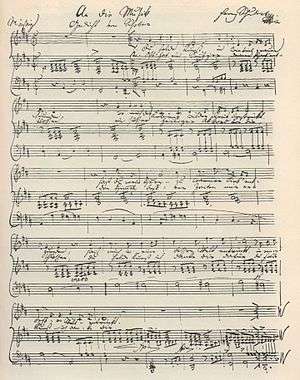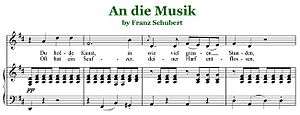An die Musik

Franz Schubert composed his lied "An die Musik" (German for "To Music") in March 1817 for solo voice and piano, with text from a poem by his friend Franz von Schober. In the Deutsch catalog of Schubert's works it is number 547, or D547. The original key is D major.[1] It was published in 1827 as Opus 88 No. 4 by Weigl. Schubert dedicated the song to the Viennese piano virtuoso Albert Sowinsky on April 24, 1827, a decade after he composed it.[2]
A hymn to the art of music, it is one of the best-known songs by Schubert. Its greatness and popularity are generally attributed to its harmonic simplicity, sweeping melody, and a strong bass line that effectively underpins the vocal line.[3]
Text

| Original German | English Translation |
|---|---|
|
Du holde Kunst, in wieviel grauen Stunden, Oft hat ein Seufzer, deiner Harf' entflossen, |
You, noble Art, in how many grey hours, Often has a sigh flowing out from your harp, |
The poem was not included in the collected editions of Schober's poems, but there is a handwritten copy of it in Vienna.[1] It resembles the second canto of Ernst Schulze's poem Die bezauberte Rose (The Enchanted Rose), a poem also known to Schubert as a possible basis for an opera; however, it was published in 1818, so it is unlikely that there was any connection between them for the composer.[1]
Other

At the end of Gerald Moore's farewell concert in London's Royal Festival Hall in 1967, in which he accompanied Dietrich Fischer-Dieskau, Victoria de los Ángeles and Elisabeth Schwarzkopf, he came out onto the stage alone and played the piano part of An die Musik as his parting gift.
This song is sung in unison by all of the members of the National Association of Teachers of Singing (NATS) who are present at the end of each of its national conventions.
It was also performed by Garrett Morris on Saturday Night Live on May 22, 1976.
The opening track of folk artist Josephine Foster's 2006 album, A Wolf In Sheep's Clothing, is a rendition of the lied.
The song is used in the 2004 film Look at Me and the 2012 film Moonrise Kingdom.
The inscription “An die Musik” is the epitaph on Ruth Laredo's gravestone in Kensico Cemetery, Valhalla, Westchester County, New York (only a few meters away from Sergei Rachmaninoff's grave).
Footnotes
References
Fischer-Dieskau, Dietrich, tr. Kenneth S. Whitton (1978). Schubert's Songs: A Biographical Study. New York: Alfred A. Knopf. ISBN 0-394-48048-1.
Reed, John (1985). The Schubert song companion. New York: Universe Books. pp. 36–37. ISBN 0-87663-477-3.
External links
- An die Musik: Scores at the International Music Score Library Project (IMSLP)
- Free sheet music of An die Musik from Cantorion.org
- More information and other translations